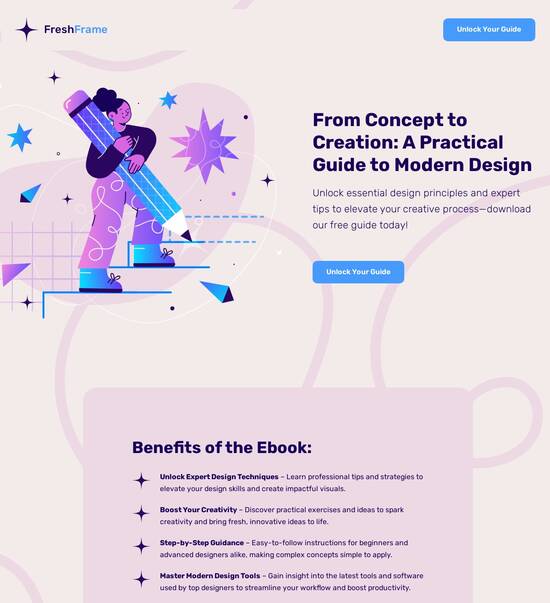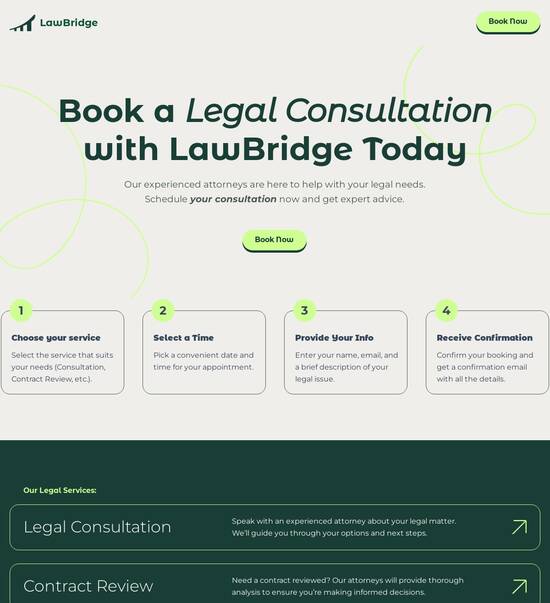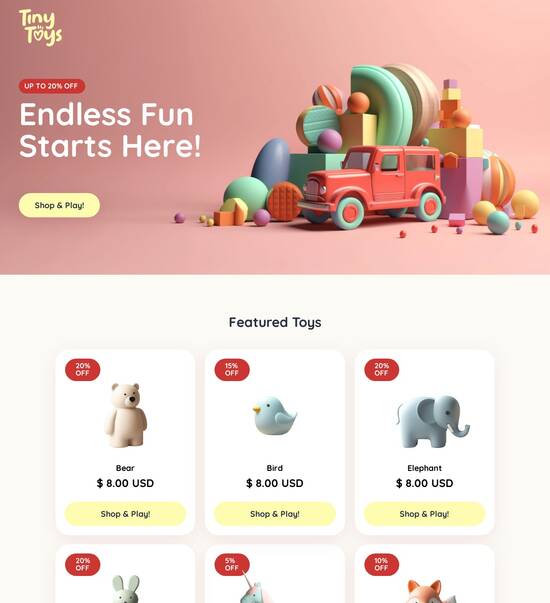
HTML page template for leather goods stores
Use TemplateAbout template
Showcase your products with stunning landing page templates for your leather goods stores. Ready to boost those sales?
Recommended templates

Easy to build without coding
With the intuitive drag-and-drop builder, anyone on your team can create high-converting pages without any knowledge of code or design. Make enhancements to your landing page with custom widgets using Javascript, HTML/CSS, or third-party scripts.

Multiple layouts for any industry and goal
Select from 500+ landing page layouts built to boost conversions across industry-specific scenarios. Customize them by adjusting fonts, adding images, and generating on-brand content with the AI assistant. Quickly scale with Instablocks® and Global Blocks that you can save, reuse, and update globally.

Loads fast and looks polished on any device
Every template is responsive, which means they present professionally on any device and load blazingly fast with our Thor Render Engine. You can also power them up with Google AMP technology to deliver an unparalleled mobile experience and drive higher conversions.

Robust analytics & experimentation
Get real-time updates and reporting across all your devices, showing the number of visitors, conversions, cost-per-visitor, and cost-per-lead. Launch AI-powered experiments, run A/B tests, and use heatmaps to analyze user behavior, then optimize your landing page to maximize conversions.







Easy to build without coding
With the intuitive drag-and-drop builder, anyone on your team can create high-converting pages without any knowledge of code or design. Make enhancements to your landing page with custom widgets using Javascript, HTML/CSS, or third-party scripts.
Multiple layouts for any industry and goal
Select from 500+ landing page layouts built to boost conversions across industry-specific scenarios. Customize them by adjusting fonts, adding images, and generating on-brand content with the AI assistant. Quickly scale with Instablocks® and Global Blocks that you can save, reuse, and update globally.
Loads fast and looks polished on any device
Every template is responsive, which means they present professionally on any device and load blazingly fast with our Thor Render Engine.
Robust analytics & experimentation
Get real-time updates and reporting across all your devices, showing the number of visitors, conversions, cost-per-visitor, and cost-per-lead. Launch AI-powered experiments, run A/B tests, and use heatmaps to analyze user behavior, then optimize your landing page to maximize conversions.
All the features you need to build lead-generating landing pages
Explore more featuresLearn how to build top-performing landing pages for any goal
FAQs
Leading the way in building high-performing landing pages





Maximize your marketing potential with Instapage landing pages
If you're looking to significantly enhance your digital marketing efforts, an effective landing page is crucial. Instapage empowers marketers in various sectors, from business services to education, providing a powerful landing page and conversion rate optimization (CRO) platform designed to maximize your return on investment (ROI). With over 100 high-converting templates at your disposal, launching a successful campaign has never been easier.
Understanding the importance of landing pages
Landing pages are tailored web pages designed with a single focus or goal, ideal for converting visitors into leads or customers. Recognizing this, Instapage offers flexible, easy-to-use tools that help you build landing pages that perform. With no coding needed, you can craft pages that resonate with your audience while aligning with your marketing objectives.
- Enhanced conversion rates: Optimizing your landing pages increases your chances of turning visitors into leads.
- Cost-effective marketing: Reduce the budget spent on unproductive campaigns by leveraging high-converting templates.
- Streamlined processes: Instapage's intuitive builders enable faster campaign execution and improved team collaboration.
Step 1: Choose the right template
Selecting an effective template is the foundation for a successful landing page. With Instapage's diverse library, you can find a layout that aligns perfectly with your campaign’s goals.
- Select based on industry: Choose a template tailored for your sector, whether it's tech, education, or financial services.
- Match your campaign’s intent: Identify templates designed for lead generation versus sales-driven objectives.
- Optimize for mobile: Ensure your chosen template is responsive and provides an optimal experience across devices.
Step 2: Customize your landing page
Once you have selected a template, customization is crucial. Instapage allows you to personalize content to resonate with your audience, enhancing engagement and conversion rates.
- Dynamic text replacement: Tailor headlines and body content based on the user's previous interactions.
- AdMaps integration: Coordinate ad campaigns with relevant landing pages for better targeting.
- Visual branding: Incorporate your brand colors and logos to foster familiarity and trust among visitors.
Step 3: Optimize and analyze
Optimization is key to achieving high conversion rates. Use Instapage’s built-in experimentation features to run A/B tests, analyze visitor behavior, and adapt pages accordingly.
- Use heatmaps: Visual demonstrations of where users click helps refine your landing page layout.
- Analytics dashboard: Gain insights into the performance of different elements, from CTAs to images.
- Continuous improvement: Employ A/B testing to iterate on design and messaging regularly.
In conclusion, leveraging the capabilities of Instapage can transform your digital marketing strategy. With its extensive template library, easy customization, and robust optimization tools, marketers can maximize their ROI efficiently.
Ready to drive real results with your digital campaigns? Start your free trial with Instapage today and explore how our platform can elevate your marketing efforts.
HTML page templates for leather goods stores
Understanding HTML page templates: The backbone of leather goods stores
In the landscape of e-commerce, having a well-structured HTML page template is crucial for success, particularly in niche markets like leather goods. These templates serve as a blueprint for designing web pages that effectively showcase products, facilitate sales, and enhance user experience. Their importance cannot be overstated as they provide a cohesive and attractive presentation of the brand's offerings.
Defining HTML page templates
An HTML page template is a pre-designed webpage that can be reused for various content types while maintaining consistency in style and structure. These templates streamline the web design process by providing a foundation that web developers can build upon. For leather goods stores, an effective template should highlight products while providing essential information and a straightforward purchasing pathway.
Essential components of effective HTML templates include semantic HTML elements like , , , , and . Each plays a vital role in organizing the content and enhancing accessibility. Additionally, integrating functional CSS and JavaScript is crucial for styling and interactivity, ensuring that the users have a seamless experience navigating through the e-commerce site.
Navigating the unique needs of leather goods stores
Special considerations for leather goods stores include the format and style of product showcasing. High-quality imagery is paramount; leather goods often hinge on texture and color to appeal to potential customers. Bright, crisp images should be utilized that allow customers to experience the product visually, as leather is a tactile material that often benefits from a close-up presentation.
Moreover, user experience (UX) and aesthetics must strike a balance where functionality complements design. A clean and attractive layout draws users in and encourages them to explore more items, ultimately leading to increased conversions. It’s essential to keep navigation intuitive, so that users can quickly find the products they desire without unnecessary distractions.
Key features of HTML page templates for leather goods stores
Responsive design is a critical feature of page templates, ensuring that every customer, whether on a mobile phone, tablet, or desktop, can easily navigate the store. With the rise of mobile shopping, having mobile-friendly pages is not just an option but a necessity. CSS media queries can be employed to create flexible layouts that adjust seamlessly to different screen sizes.
Another important aspect is dynamic product displays. Crafting appealing galleries through the use of and tags allows for a visually organized presentation. These elements enhance the user interface by combining visuals with descriptions, creating a richer browsing experience for potential buyers.
Responsive design for mobile-friendliness.
Dynamic product presentations using HTML tags.
Integration of rich media content for engagement.
Technical considerations and best practices
To enhance interactivity in web applications, utilizing document.addEventListener is crucial. This method simplifies event handling by allowing developers to set up event listeners for various actions, such as click events for product details. The use of such listeners creates an interactive environment that can improve user engagement.
Additionally, employing DOMContentLoaded is vital for optimizing loaded content. Understanding when the document has been completely loaded prior to performing actions greatly enhances loading times and overall performance. Developers should implement best practices such as minimizing resource loading and only executing scripts when the DOM is ready.
Use of document.addEventListener for improved user engagement.
Optimization of loading time with DOMContentLoaded.
Incorporation of SEO strategies within templates.
Visual and functional elements of HTML templates
Creating an effective hero section is essential for making a lasting first impression on users when they land on the page. Hero images should be visually appealing and optimized to load quickly, while strategically positioned call-to-action buttons can guide users towards making a purchase or exploring more products.
A well-optimized navigation bar is another necessity. Dropdowns and links should be intuitive, enabling users to access product categories quickly. This ensures that customers can efficiently browse through the range of products offered, improving usability and satisfaction. By focusing on simplicity and organization within the navigation menu, stores can provide a better overall user experience.
Enhancing the shopping experience
Integrating a functional shopping cart into HTML templates is paramount for e-commerce stores. The design should prioritize usability, allowing users to add items with ease while providing visual cues like badges or counters to indicate the number of products in the cart. An engaging and intuitive shopping cart experience can significantly boost sales.
Additionally, showcasing user reviews and testimonials can enhance credibility and encourage conversions. Social proof plays a crucial role in influencing purchase decisions, so displaying reviews on product pages can effectively communicate quality and satisfaction. Various techniques can be employed to effectively highlight positive feedback, including dedicated sections or sliders.
Customization and scalability
Customizing templates to reflect brand identity is critical. Factors such as color schemes, typography, and logo placement should align with the overall branding strategy. This consistent branding across the website builds trust and creates a recognizable online presence.
Furthermore, scalability should be a core consideration during the design phase. Templates must be adaptable to accommodate changes in inventory or features. Employing modular design principles enables ease of updates and extensions, ensuring that the store can grow smoothly without major disruptions.
Brand identity alignment with templates.
Scalable design for future growth.
Use of modular designs for easy feature integration.
Trends in leather goods e-commerce aesthetics
Staying updated with design trends is essential for success in leather goods e-commerce. Popular color palettes, functionalities, and layout trends can significantly affect consumer behavior. Engaging with case studies from successful leather goods stores can provide insights into effective strategies and highlight elements that resonate well with customers.
Current trends may feature earthy tones that evoke a sense of sophistication, alongside minimalist designs that focus on product presentation. Implementing customer-centric features like virtual try-ons or detailed craftsmanship videos can also play a significant role in encouraging purchases by elevating the shopping experience.
Utilizing development tools for optimal performance
To create efficient and responsive HTML templates, leveraging frameworks such as Bootstrap or Tailwind CSS can greatly simplify the development process. These libraries provide pre-built components that streamline layout structure and enhance responsiveness, allowing developers to focus on creating attractive features tailored to leather goods stores.
In addition, maintaining code integrity through version control and collaboration tools is vital, especially in team environments. Platforms like Git allow developers to track changes, collaborate on code, and roll back to previous versions if needed, ensuring smooth workflow and code quality.
The future of HTML page templates for e-commerce
Looking ahead, the evolution of emerging technologies will significantly influence HTML page templates for leather goods stores. The rise of headless content management systems (CMS) allows for greater flexibility in content delivery and improved integration with various e-commerce functionalities. This shift can streamline the creation of engaging user experiences while enhancing site performance.
Moreover, the transition towards AI-driven personalization in shopping experiences is expected to create customized pathways for customers. Leveraging data to tailor recommendations and experiences will not only enhance user engagement but is also anticipated to improve conversion rates, making it essential for e-commerce businesses to stay ahead of the curve.
Ready to skyrocket conversions?
Supercharge your ad campaigns with high-performing landing pages
Get started














